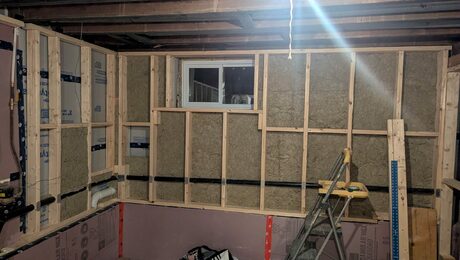Our home was built in 1903.
Much of the upstairs has partially-vaulted ceilings (picture attached). The roof is framed in rough 2X4 Douglas Fir. There is blocking between each of the rafters on the top plate. Over the years someone has stuffed angel hair down the wells between roof deck (skip sheathing) and ceiling lath. The end result is impressive ice dams over the areas where the ceilings are vaulted.
Would I be correct in:
Cutting vents in the eaves;
Drilling through the blocking between the rafters;
Fishing out the angel hair?
It would be great to put in some sort of baffle, but I don’t think that’s a project I can do before this winter hits.
Thanks for any counsel you can give me.



















Replies
As you are aware, ice dams are caused by heat from inside the house melting snow on the roof, where it heads down the roof a bit, then freezes as soon as it gets past the part of the roof heated by the house.
The solution is a combination of ventilation of the bottom of the roof deck, which combined with air sealing and insulation, can maintain the roof deck below freezing until the ambient temps (and roof over the overhang) get above freezing.
Opening up only the bottom end is not likely to help that much.
Remember that venting guidance includes splitting the net free vent area between ridge and eave. (air needs to move in order to carry heat from the roof cavity before it warms up the roof deck)
Things that might help
Installation of better insulation within the roof space. (and in the walls below, which likely are also a source of heating of the roof deck) (dense pack blown cellulose is one option.)
Installation of mitigation from ice damage, and water above the ice dam.
Ice and water shield (probably need solid sheathing over the skip sheathing), Or some of the metal shields common in northern cities full of older houses such as yours.
aka ice belt panels.
https://www.roofingcalc.com/top-15-ice-dam-prevention-produts-and-costs/
This site seems to have some discussion you may be interested in
Thanks, UM. As always, very helpful.
I guess I wasn't fully descriptive. The roof was cedar shakes when we bought four years ago. The work had not been done right, and the roof started failing after about 13 years. From the literature, a shake roof ought to be good for over 30. There were only about 2/3 as many shakes as there should have been, just not enough coverage and overlap.
Regardless, a couple of years ago we had it re-roofed in asphalt shingles, including putting continuous decking over the skip sheathing.
When they did the new roof they put in a ridge vent. At least part of the problem is that there is zero potential for ventilation through the areas where the roof deck is only four inches from the ceiling lath. And those are the ONLY areas where we are getting ice dams.
As far as insulation, there is a combination of fiberglass (at the bottom), blown cellulose (middle layer) and something white (maybe fiberglass again, although it doesn't make me itch). Thankfully, no vermiculite. It is as much as 24-30 inches deep in some places, and blown in right against the roof deck (which probably voids my shingle warranty).
I have plans to have the whole thing vacuumed out, seal the penetrations, install baffles, and re-blown. Those might just be dreams.
Still, the only places I get the ice dams is where the ceiling is partially vaulted. So I thought the issue might be that the heat in those places, combined with a total lack of ventilation through them, could be the issue.
You could also add some insulation inside. Sheet foam covered by drywall can do a lot.
(drywall over sheet foam needed for fire protection) Rigid rock wool is another thing to consider.)
both these take up interior room, but the option is to tear up the roof and raise the decking to make room for ventilation space and insulation.
Did your roofer install ice and water shield over this part of the roof?
If you get leaks inside from the ice dam, that is another intermediate option. (tear off the shingles and put ice and water shield under a new set where this is a problem)
In this area at least 3' of ice & water shield is required.
I have to do a repaint next summer. At that time I may remove the soffits and work out some sort of solution to this problem.
Drilling through the blocking without adding baffles to the rafter bays seems like a gamble. Insulation may get blown away from edges of ceiling or it may fall down and block holes. Much better to drill holes and add baffles at the same time.
Everything I've seen in the literature (such as https://www.buildingscience.com/documents/insights/bsi-046-dam-ice-dam) suggests a 3 level hierarchy for solving ice dam problems where you only move to the next level after you are sure you've fully addressed the prior (more important) levels-
1. air seal ceiling / attic ducts
2. insulate ceiling / attic ducts
3. ventilate under roof
If you have can lights or other air leaks in your ceiling then adding more ventilation under the roof is unlikely to help much. Your dreams sound like the right idea, probably easiest to just do it all at once next summer.